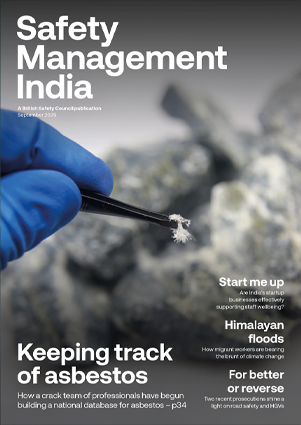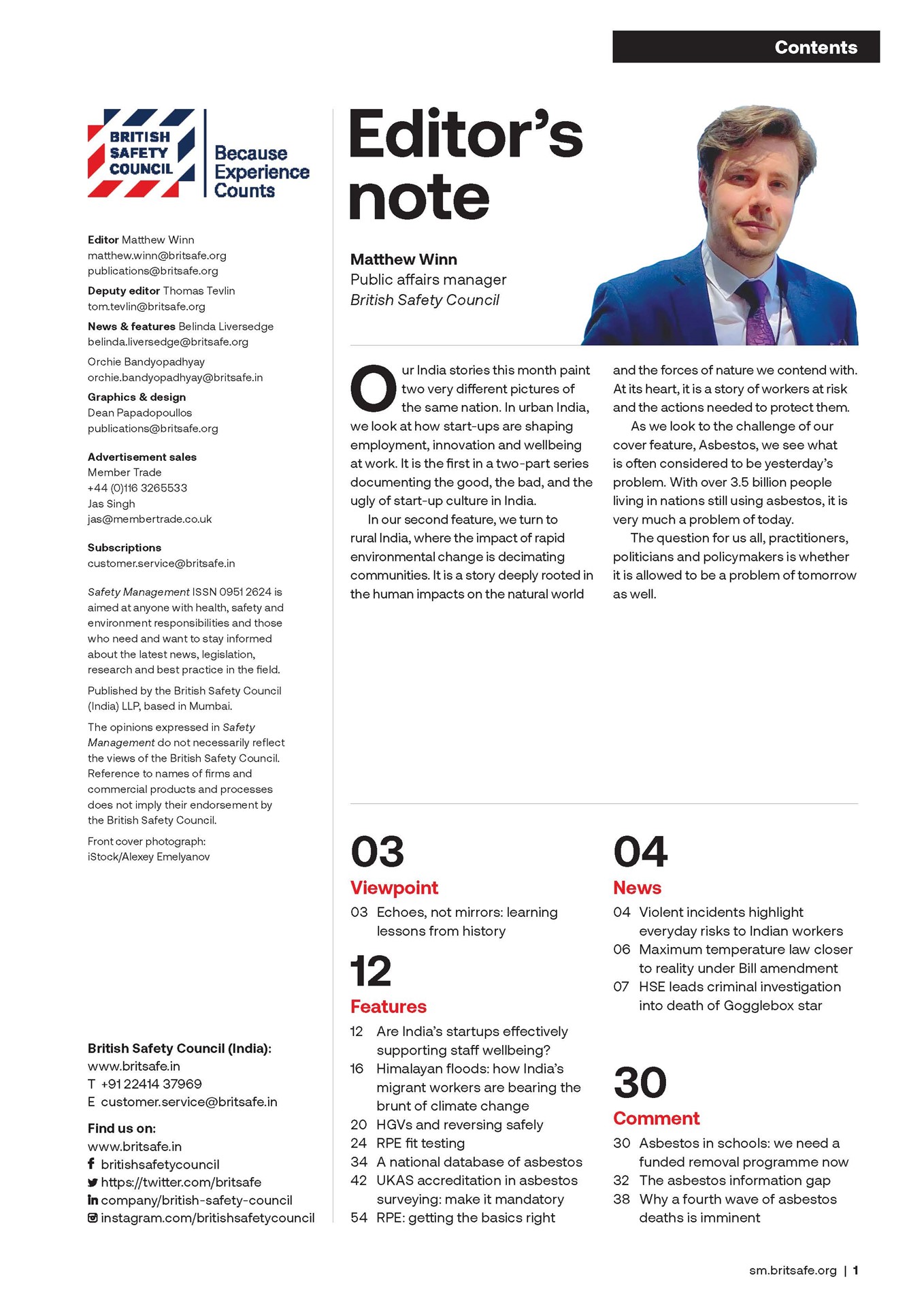Although many countries have banned the use of asbestos, the deadly substance continues to be used widely in India, placing workers and others at serious risk.
Features
Asbestos in India: a common hazard
Although the use of asbestos is banned in 70 countries – and India banned the mining of asbestos in 2011 – India continues to be the second largest consumer of asbestos in the world.
Last year, Union Minister of Mines, Coal and Parliamentary Affairs Pralhad Joshi told the Lok Sabha that currently no asbestos mine was functioning in India. This was according to information provided by the Indian Bureau of Mines, a subordinate office of the Union Ministry of Mines.
 Photograph: iStock - credit Anil Dave
Photograph: iStock - credit Anil Dave
However, India is the world’s largest importer of the toxic mineral, with a 46 per cent share of all asbestos imports globally, with a value of $160 million.
A study co-funded by white chrysotile asbestos companies, and undertaken by the National Institute of Occupational Health (NIOH), Ahmedabad, found that in 2019-20, India imported 361,164 tonnes of asbestos, and in the previous year imported 364,105 tonnes.
According to Ban Asbestos Network India (BANI), a group that campaigns to improve public and societal awareness about the health risks from asbestos, although almost all the imported asbestos is chrysotile asbestos, India also imports a small amount of non-chrysotile asbestos. The imports of chrysotile asbestos mainly come from Russia (85 per cent), Brazil, Kazakhstan and Hungary (three per cent each), and Poland and South Africa (two per cent each), according to BANI.
“The data reveals that despite the Brazilian Supreme Court’s landmark verdict declaring the use of asbestos to be unconstitutional, it is exporting the material to India not realising that human biology is the same everywhere,” said Gopal Krishna, an anti-asbestos activist and convener of BANI. He added: “What is poisonous for Brazilians and some 70 countries cannot be non-poisonous for Indians.”
Other than chrysotile asbestos, India imports asbestos cement products, asbestos rock and other products.
Today, the supply and use of asbestos-containing materials is a multi-billion dollar global industry that has seen double-digit growth in recent years – despite the widely known occupational and environmental health hazards posed by the material.
One million asbestos deaths globally per year
The World Health Organization (WHO) says that globally, about 125 million people are directly exposed to asbestos in their workplace every year, and it is estimated that more than one million workers die every year from an asbestos-related disease.
A paper on Global Asbestos Disaster published in the May 2018 issue of the International Journal of Environmental Research and Public Health estimated that for every 20 tonnes of asbestos produced and consumed there is at least one death of a person somewhere in the world.
Although occupational exposure to asbestos is the number one cause of asbestos-related deaths, secondary exposure is becoming more common, where people are unaware they have been exposed to the material.
Secondary exposure often occurs when workers inadvertently bring home asbestos fibres that have become stuck to their clothes and hair, exposing others in their household to the substance.
When 41-year-old Rajesh Vyas, a resident of Ahmedabad, died of mesothelioma – an aggressive cancer of the lining of the lungs most commonly caused by inhaling asbestos particles – his family found it hard to believe his death was due to asbestos exposure. This was because Rajesh did not work at an asbestos factory. However, his father worked as an engineer at Gujarat Composite, a factory in Ahmedabad that manufactures asbestos cement roof sheets.
The family spent years in a residential area meant for the factory’s workers and their house was in front of an asbestos waste dump site. In all likelihood, Rajesh Vyas was exposed to asbestos there.
According to medical professionals, mesothelioma is one of the most aggressive cancers, with a grim five-year survival rate of only eight per cent. After diagnosis there is little that can be done to stop the progression of the disease, they state.
New Delhi-based research and community development organisation Environics Trust states that despite the denials of India’s states and various industries and businesses, nearly 1,500 occupational victims of mesothelioma have been identified up to now in India along with some others who are thought to have suffered environmental exposure. Certain Indian workers are at risk of asbestos exposure while servicing asbestos-containing automotive brakes, cutting asbestos-coated cement pipes and applying spray-on asbestos fireproofing materials.
Due to its remarkable thermal qualities and fire-retardance, asbestos – specifically chrysotile asbestos, also known as white asbestos – is still extensively used in a number of industrial processes in India. These include the manufacture of asbestos-cement sheets and pipes, brake shoes, brake linings, clothes and ropes. It is also used in cement construction like roofing, jointing and gaskets and asphalt coats and sealants. Asbestos is also one of the most hazardous materials handled by workers at the Alang shipyard in Gujurat, where old and decommissioned ships are dismantled.
According to estimates, there are more than 100 asbestos manufacturers in India employing 300,000 workers.
Informal sector may face increased asbestos risk
As India’s most hazardous industries are primarily in the informal sector, informal workers face dangerous working conditions and only have limited legislative protection in the event of them suffering work-related injuries and illnesses.
Experts point out that even in the asbestos manufacturing units operating in the formal sector, a large section of the workforce is informal, and are contract or casual workers.
Informal workers have little or no job security and are entitled to few employment and social security protections and benefits, which means they often move from one workplace to another. The informal nature of their employment – and the fact they regularly move jobs – has made it easier for some unscrupulous employers to avoid meeting their duty to maintain health records for workers for at least 40 years, as ordered by the Supreme Court.
In January 1995, the Supreme Court issued an order directing all industries and the official respondents to compulsorily maintain and retain health records for each workman for a period of 40 years from the date the workman begins employment – or 10 years after their employment ends – whichever is the later.
“Because of the mobility of the [informal sector] workers, the documentation naturally becomes difficult. And this is a smart tactic adopted by industry to get away with [failing to pay] the compensation cost [for work-related diseases],” says Krishna.
Asbestos roofs used for low-cost slum housing
Also, marginalised communities in India live and work under asbestos roofs as most Indian slums in semi-urban and rural areas use asbestos in the roof materials.
The National Institute for Health and Family Welfare estimates that exposure to asbestos has resulted in a higher incidence of cancer among those living under asbestos roofs.
 Photograph: iStock - credit Anil Dave
Photograph: iStock - credit Anil Dave
“Around 79 per cent of the Dalits, a marginalised community, whose population hovers around 200 million in India, live in houses with asbestos roofs,” says Krishna.
He adds that in slum housing, “most water pipes are made of asbestos cement”. Roofs and water pipes made from asbestos are used in low-cost housing because they are thought to be cheap and reliable materials, says Krishna.
Asbestos has been used for different purposes since prehistoric times, and the fibrous material was once viewed as valuable to mankind. However, the global campaign today aimed at banning its use continues to gain momentum, due to awareness of how exposure can lead to fatal and serious diseases. When asbestos materials are damaged or broken during processing, the tiny fibres become airborne and can be easily inhaled at a significant rate. Once inhaled, asbestos fibres lodge in the lining of the throat, lung, or stomach, causing cells to mutate and become cancerous.
According to the WHO, all types of asbestos cause lung cancer, mesothelioma, cancer of the larynx and ovary, and asbestosis (fibrosis of the lungs).
Exposure to asbestos occurs through inhalation of fibres in the air in the working environment, ambient air in the vicinity of point sources such as factories handling asbestos, or indoor air in housing and buildings containing friable (crumbly) asbestos materials.
The WHO underlines that several thousand deaths can be attributed to other asbestos-related diseases, as well as to non-occupational exposures to asbestos.
India’s Supreme Court and high courts have repeatedly voiced their concerns about the health risks to workers and people due to exposure to asbestos. They have also asked the central and state governments to update India’s laws to bring them into line with an International Labour Organisation (ILO) resolution calling for a global ban on all uses of white chrysotile asbestos to safeguard human health.
According to Environics India, although current cases of asbestos-related disease in India are due to past exposures, the only way to reliably prevent future asbestos-related diseases is to introduce strict and effective legal controls that will prevent workers being exposed to the material.
Also, commentators say the medical profession can help raise awareness of the health dangers and the need for stricter rules to prevent workplace exposure through accurate diagnosis and public reporting of all cases of asbestos-related disease. It is a collective responsibility and everyone has to play their part in pressurising the Indian government and Indian businesses to do more to prevent asbestos exposure at work and elsewhere, say campaigners.
A spokesperson from the Centre for Environmental Health in India warned that until the use of asbestos is banned in India, there is an urgent need to protect workers from exposure.
“Strict workplace regulations, provision of personal protective gear, methods to reduce exposure, medical monitoring of occupational exposures, worker training programmes could go a long away to protect India’s workers and their families from asbestos,” said the Centre for Environmental Health spokesperson.
However, there are some examples of businesses taking action to phase out the use of asbestos and therefore protect workers and the public from exposure. For instance, Indian Railways, one of the largest consumers of asbestos-based roofing sheets, has decided to phase out the use of asbestos-based sheets.
There are around 8,000 railway stations in India, most of which have asbestos present somewhere. The product is used as roofing and partition material for stations, workshops and workers’ quarters.


FEATURES
Paper vs digital – how CFTS is revolutionising work equipment inspections for members
By on 01 January 0001

